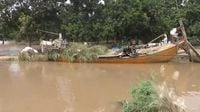Pakistan’s eastern Punjab province is reeling from the most catastrophic flood in its recorded history, with millions affected and the country’s economy under severe threat. As rivers swelled to unprecedented levels and villages disappeared beneath the waters, authorities scrambled to protect lives and salvage what they could of the region’s crucial agricultural output.
On Sunday, August 31, 2025, officials confirmed that the Sutlej, Chenab, and Ravi rivers—three of Punjab’s major waterways—had all risen to all-time highs. According to the Associated Press, this marks the first occasion these rivers have simultaneously reached such dangerous levels. The flooding has put roughly 2 million people at risk, with more than 1,400 villages inundated and thousands of farms washed away across the province.
“This is the biggest flood in the history of the Punjab. The flood has affected 2 million people. It’s the first time that the three rivers — Sutlej, Chenab, and Ravi — have carried such high levels of water,” Maryam Aurangzeb, the senior minister for Punjab, announced at a press conference. Her words, reported by both AP and Reuters, echoed the sense of alarm gripping the region.
The devastation has been fueled by a combination of shifting weather patterns and climate change. Punjab received 26.5% more monsoon rain between July 1 and August 27, 2025, compared to the same period last year, according to Pakistan’s national weather center. Downpours and cloudbursts have triggered flash floods and landslides not only in Punjab but also across Pakistan’s mountainous north and northwest.
But the deluge has not been entirely the work of nature. Indian authorities, facing their own overflowing dams and swollen rivers, released large volumes of water from their reservoirs into rivers that flow into Pakistan. This cross-border release, while routine during heavy monsoon years, contributed to the surge in Punjab’s rivers. India issued three flood warnings to Pakistan during the week of August 24–30, 2025, describing them as a humanitarian gesture. This marked the first public diplomatic contact between the two rivals since a crisis brought them to the brink of war in May.
Pakistan’s Foreign Ministry is now collecting data on what it describes as India’s “deliberate release of water into Pakistan.” There has been no immediate comment from Indian officials, but the warnings did give Pakistani authorities some time to prepare, if only marginally.
The impact on communities has been dramatic and heartbreaking. Local authorities have evacuated more than a million people from their homes in Punjab, using schools, police stations, and security facilities as makeshift rescue camps. Television footage has shown residents clambering into rescue boats, their belongings piled high, as they sailed over submerged farmland to safety. Others waded through chest-high water, clutching children and livestock, leaving behind homes that may never be habitable again.
“Our animals are starving, and we are also not getting food anywhere else,” said Emaan Fatima, a resident who sought shelter in a government camp. “We are not sitting here by choice. Our houses are in danger. We are very worried.”
Officials in Multan, a major city in southern Punjab, took extraordinary measures to protect urban areas. Explosives were installed at five key embankments to divert water away from the city if the Chenab River’s massive wave threatened to breach defenses. Drones hovered over low-lying neighborhoods, and teams worked tirelessly to persuade reluctant residents to evacuate. “The water is coming in large quantities — we cannot fight it, we cannot stop it,” Multan Deputy Commissioner Wasim Hamad Sindhu pleaded, urging people to seek shelter in the camps.
In Qadirabad village, the threat was even more acute. The Chenab River’s flow reached nearly 1 million cusec (cubic feet per second) overnight—well above the 800,000 cusec capacity of the 3,300-foot concrete barrage that regulates the river. To prevent a catastrophic collapse, authorities deliberately blew up parts of the riverbank, releasing water onto nearby land and sparing two towns from disaster. By Thursday afternoon, the river’s flow had dropped to 754,966 cusec, but the sense of relief was tempered by the knowledge that more rain could come.
For many, the trauma is still fresh. “We spent the whole night awake and frightened,” Nadeem Iqbal, a laborer from Qadirabad, told Reuters as he waded through the floodwaters with his child. “Everyone was frightened. Kids cried. Women were worried. We were helpless.”
The human toll has been staggering. Since late June 2025, at least 849 people have died and 1,130 have been injured across Pakistan in rain-related incidents, according to the country’s disaster management authority. In Punjab alone, at least 12 people lost their lives in the week leading up to August 28. The chief minister of Sindh province, Murad Ali Shah, has warned of a potential “super flood” if water levels at key barrages exceed 900,000 cusec—a scenario officials are fighting desperately to avoid.
Punjab, home to about 150 million people, is the heart of Pakistan’s agricultural sector and its main wheat producer. The floods have already washed away thousands of villages and farms, submerging vital grain crops and threatening the nation’s food security. The devastation echoes the ferocious flooding of 2022, which wiped out vast swathes of crops in the east and south of the country and led to dire warnings of food shortages from Prime Minister Shehbaz Sharif.
The economic ramifications are already being felt. Officials expect the August inflation reading, due Monday, to be between 4% and 5%, with food shortages driving prices sharply higher. As the waters recede, the full scale of the damage to infrastructure, homes, and livelihoods will become clearer, but the road to recovery is certain to be long and arduous.
Pakistan’s monsoon season typically runs until the end of September, leaving little respite for exhausted emergency teams and anxious residents. The head of Pakistan’s National Disaster Management Agency, Inam Haider Malik, pointed to a convergence of weather systems from the east, south, and west as a factor in this year’s unprecedented monsoon. Planning Minister Ahsan Iqbal put it bluntly: “Climate change is the new normal. But it isn’t unmanageable.”
As the country braces for further challenges, the resilience of Punjab’s people and the coordination between local, national, and international agencies will be tested like never before. The hope is that the lessons learned—and the warnings heeded—will help Pakistan weather storms yet to come.



